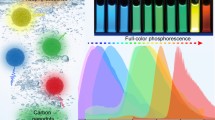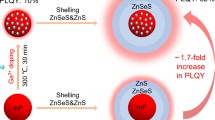Abstract
The structural and optical properties of polypyrrole-ZnO (PPy-ZnO) composites with different amount of ZnO are investigated. The nature of optical absorption and emission of the composites having agglomerated granular morphology is explored. Addition of ZnO slightly affects the conjugation of the polymer chain due to which the π-π* transition of PPy-ZnO composite shows some blue shift in the UV-Vis absorption spectra. The photoluminescence intensity of PPy-ZnO nanocomposite varies with variation of ZnO content. This tunability in the photoluminescence intensity of PPy-ZnO nanocomposite can be understood in terms of Forster Resonance Energy transfer (FRET) from ZnO (donor) to PPy (acceptor). The energy transfer efficiency, Forster radius and separation between donor and acceptor are predicted theoretically by using a FRET model. With the change in donor concentration, the energy transfer efficiency changes which affects the emission intensity of composites. The highest emission intensity is observed for 1.22 g of ZnO which indicates the highest energy transfer between ZnO and PPy. Thus, by tuning ZnO content the emission properties of the PPy-ZnO composite can be tuned.

Highlights
-
Semiconducting PPy-ZnO composites are synthesised here with different amount of ZnO.
-
Enhanced photoluminescence is obtained in composite as compared to pristine PPy.
-
FRET from ZnO to PPy is responsible for the PL enhancement.
-
Blue emission from all the composites is observed.











Similar content being viewed by others
References
Dabbousi BO, Bawendi MG, Onitsuka O, Rubner MF (1995) Electroluminescence from CdSe quantum‐dot/polymer composites. Appl Phys Lett 66(11):1316–1318
Tessler N, Medvedev V, Kazes M, Kan S, Banin U (2002) Efficient near-infrared polymer nanocrystal light-emitting diodes. Science 295(5559):1506–1508
Huynh WU, Dittmer JJ, Alivisatos AP (2002) Hybrid nanorod-polymer solar cells. Science 295(5564):2425–2427
Peiró AM, Ravirajan P, Govender K, Boyle DS, O'Brien P, Bradley DD, Durrant JR (2006) Hybrid polymer/metal oxide solar cells based on ZnO columnar structures. J Mater Chem 16(21):2088–2096
Selmarten D, Jones M, Rumbles G, Yu P, Nedeljkovic J, Shaheen S (2005) Quenching of semiconductor quantum dot photoluminescence by a π-conjugated polymer. J Phys Chem B 109(33):15927–15932
Lutich AA, Jiang G, Susha AS, Rogach AL, Stefani FD, Feldmann J (2009) Energy transfer versus charge separation in type-ii hybrid organic− inorganic nanocomposites. Nano Lett 9(7):2636–2640
Chatterjee S, Shit A, Nandi AK (2013) Nanochannel morphology of polypyrrole–ZnO nanocomposites towards dye sensitized solar cell application. J Mater Chem A 1(39):12302–12309
Patil P, Gaikwad G, Patil DR, Naik J (2016) Synthesis of 1-D ZnO nanorods and polypyrrole/1-D ZnO nanocomposites for photocatalysis and gas sensor applications. Bull Mater Sci 39(3):655–665
Yan B, Wang Y, Jiang X, Liu K, Guo L (2017) Flexible photocatalytic composite film of ZnO-microrods/polypyrrole. ACS Appl Mater Interfaces 9(34):29113–29119
Chougule MA, Dalavi DS, Mali S, Patil PS, Moholkar AV, Agawane GL, Patil VB (2012) Novel method for fabrication of room temperature polypyrrole–ZnO nanocomposite NO2 sensor. Measurement 45(8):1989–1996
Barkade SS, Pinjari DV, Singh AK, Gogate PR, Naik JB, Sonawane SH, Pandit AB (2013) Ultrasound assisted miniemulsion polymerization for preparation of polypyrrole–zinc oxide (PPy/ZnO) functional latex for liquefied petroleum gas sensing. Ind Eng Chem Res 52(23):7704–7712
Harpale K, Kolhe P, Bankar P, Khare R, Patil S, Maiti N, Sonawane KM (2020) Multifunctional characteristics of polypyrrole-zinc oxide (PPy-ZnO) nanocomposite: field emission investigations and gas sensing application. Synth Met 269:116542
Yang Y, Chen H, Zhao B, Bao X (2004) Size control of ZnO nanoparticles via thermal decomposition of zinc acetate coated on organic additives. J Cryst Growth 263(1–4):447–453
Chougule MA, Sen S, Patil VB (2012) Facile and efficient route for preparation of polypyrrole‐ZnO nanocomposites: microstructural, optical, and charge transport properties. J Appl Polym Sci 125(S1):E541–E547
Greenham NC, Peng X, Alivisatos AP (1996) Charge separation and transport in conjugated-polymer/semiconductor-nanocrystal composites studied by photoluminescence quenching and photoconductivity. Phys Rev B 54(24):17628
Clegg RM (2006) The history of FRET. In Reviews in Fluorescence 2006. Springer, Boston, MA, p 1–45
Haldar KK, Sen T, Patra A (2010) Metal conjugated semiconductor hybrid nanoparticle-based fluorescence resonance energy transfer. J Phys Chem C 114(11):4869–4874
Bodurov I, Yovcheva T, Sainov S (2014) Refractive index investigations of nanoparticles dispersed in water. J Phys: Conf Ser 558(Dec):012062
Ramasami AK, Ravishankar TN, Nagaraju G, Ramakrishnappa T, Teixeira SR, Balakrishna RG (2017) Gel-combustion-synthesized ZnO nanoparticles for visible light-assisted photocatalytic hydrogen generation. Bull Mater Sci 40(2):345–354
Lunz M, Bradley AL, Gerard VA, Byrne SJ, Gun’ko YK, Lesnyak V, Gaponik N (2011) Concentration dependence of Förster resonant energy transfer between donor and acceptor nanocrystal quantum dot layers: effect of donor-donor interactions. Phys Rev B 83(11):115423
Acknowledgements
We thank Central Research Facility (CRF) of IIT (ISM), Dhanbad for providing experimental facilities of SEM, UV-Vis-NIR spectrophotometer. We also acknowledge DST-FIST facility (Project No. SR/FST/PSI-004/2013) for using lifetime spectrometer. This work was financially supported by IIT(ISM), Dhanbad, India.
Author information
Authors and Affiliations
Corresponding author
Ethics declarations
Conflict of interest
There is no conflict of interest to declare. The data that support the findings of this study are available from the corresponding author upon reasonable request.
Additional information
Publisher’s note Springer Nature remains neutral with regard to jurisdictional claims in published maps and institutional affiliations.
Rights and permissions
About this article
Cite this article
Dey, S., Kar, A.K. Effect of Forster resonance energy transfer on the photoluminescence of PPy-ZnO composite. J Sol-Gel Sci Technol 102, 679–687 (2022). https://doi.org/10.1007/s10971-021-05621-y
Received:
Accepted:
Published:
Issue Date:
DOI: https://doi.org/10.1007/s10971-021-05621-y




